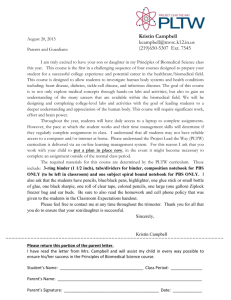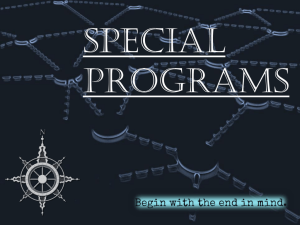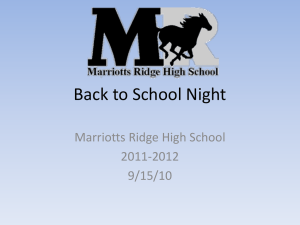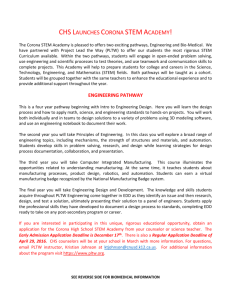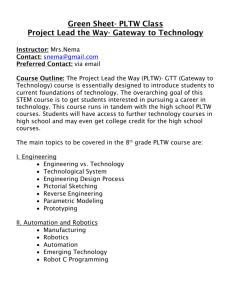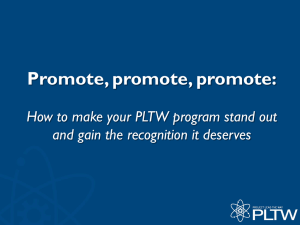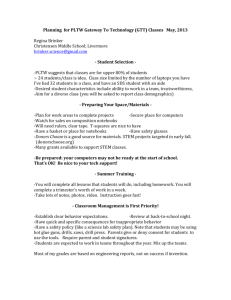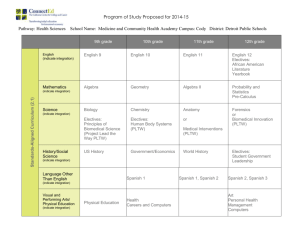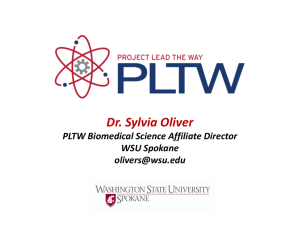Engineering & Biomedical Science Programs of Study
advertisement
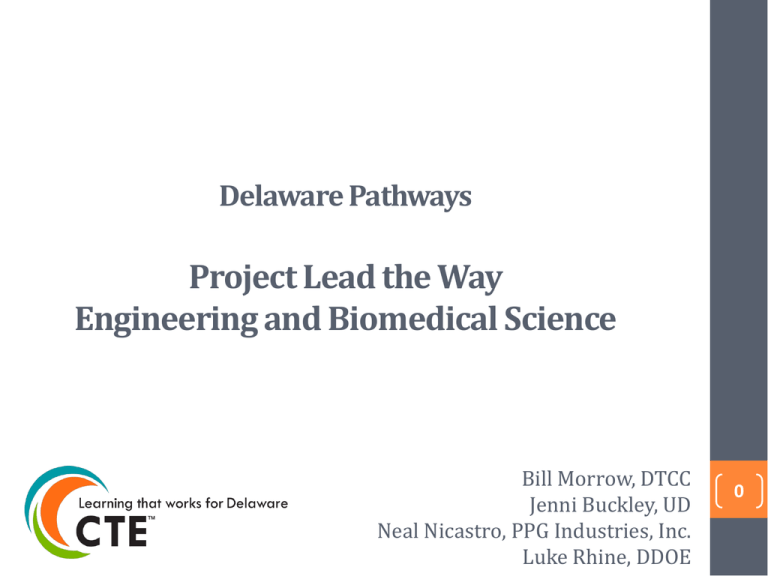
Delaware Pathways Project Lead the Way Engineering and Biomedical Science Bill Morrow, DTCC Jenni Buckley, UD Neal Nicastro, PPG Industries, Inc. Luke Rhine, DDOE 0 Framing Our Conversation Our Goals for Today: • Provide an overview of the Engineering and Biomedical Science programs of study; • Discuss professional development opportunities for teachers; • Discuss early college and early career experiences for students; and • Discuss next steps and how to submit the program application. 1 Program of Study Overview Engineering: • In comprehensive schools this pathway is a three (3) course program, in technical schools it is a six (6) course Career & Technical Education (CTE) program that engages students in open-ended problem solving, the application of the engineering design process, and use of industry-leading technology and software. • • Partners: UD, DSU, DTCC, Project Lead the Way Benefits: Curriculum and assessments developed in partnership with business & industry and higher education; course specific professional development; national and state network of support including student scholarships and early college credit. 2 STEM, Engineering (PLTW) [comprehensive schedule] Introduction to Engineering Design (IED) Students use the engineering design process to apply math and science to authentic projects. They work both individually and in teams to design solutions to a variety of problems as well as build physical and mathematical models. Principles Of Engineering (POE) Students explore a broad range of engineering topics, including mechanisms, materials, statics, vectors, and automation. Students develop skills in problem solving, research, and design while learning strategies for design process documentation, collaboration, and presentation. Engineering Design and Development (EDD) Students identify an issue and then research, design, and test a solution, ultimately presenting their solution to a panel of engineers. Students apply professional skills to document a design process to standards and as a result are ready to take on a post-secondary program or career. 3 STEM, Engineering (PLTW) [technical schedule] Digital Electronics (DE) Students are provided with a foundation in electrical engineering, electronics, and circuit design. Students study topics such as combinational and sequential logic and are exposed to circuit design tools used in industry, including logic gates, integrated circuits, and programmable logic devices. Aerospace Engineering (AE) Students learn the fundamentals of atmospheric and space flight. Students explore the physics of flight, the concepts to life by designing an airfoil, propulsion system, and rockets. Students learn basic orbital mechanics using industry-standard software and explore robotic systems through projects such as remotely operated vehicles. Civil Engineering and Architecture (CEA) Students learn fundamental aspects of building and site design and development. Students apply math, science, and standard engineering practices to design both residential and commercial projects and document their work using 3D architecture design software. 4 Program of Study Overview Biomedical Science: • This is a three (3) course Career & Technical Education (CTE) program that engages students in open-ended problem solving where students study the concepts of human medicine, physiology, genetics, microbiology, and public health. • Partners: UD, DSU, DTCC, Project Lead the Way • Benefits: Curriculum and assessments developed in partnership with business & industry and higher education; course specific professional development; national and state network of support including student scholarships and early college credit. 5 STEM, Biomedical Sciences (PLTW) Principles of Biomedical Science (PBS) Students explore concepts of biology and medicine to determine factors that led to the death of a fictional person by examining autopsy reports, investigating medical histories, and exploring medical treatments that might have prolonged the person’s life. Human Body Systems (HBS) Students examine the interactions of human body systems as they explore identity, power, movement, protection, and homeostasis. Students use data acquisition software to monitor body functions such as muscle movement, reflex and voluntary action, and respiration. Medical Interventions (MI) Students follow the life of a fictitious family as they investigate how to prevent, diagnose, and treat disease. Students explore how to detect and fight infection; screen and evaluate the code in human DNA; evaluate cancer treatment options; and prevail when the organs of the body begin to fail. 6 Professional Development Engineering, PLTW: • A two-week professional development session is required to teach each course in the program sequence. Training for the Introduction to Engineering Design (IED) course will be offered: • • • • Where: University of Delaware (UD) When: July 20 – July 31, 2015 Provided by: UD and PLTW Cost: Registration covered through a grant from PPG Industries Inc. and all additional costs for teacher participation are allowable expenses through the Innovative grant 7 Professional Development Biomedical Sciences, PLTW: • A two-week professional development session is required to teach each course in the program sequence. Training for the program is currently offered: • Where: Stevenson University (Baltimore County, Maryland) • • • When: July 20 – July 31, 2015 Provided by: Stevenson University and PLTW Cost: Registration and costs for teacher participation are allowable expenses through the Innovative grant 8 Early Career & College Experiences Work-Based Learning Experiences: • The curriculum includes opportunities for LEAs to engage their advisory committees through industry mentored projects and experiences, examples below: • • ENG – Product developed in partnership with industry board BMS – Independent research conducted in partnership with advisory board Articulation: • There are more than 60 post-secondary institutions across the country that currently offer scholarships, admission preference, and early college credit for PLTW. • In-state articulations are under development with DTCC, DSU, and UD. 9 Program of Study Application Application & Approval Process for the Engineering & Biomedical Science Programs: • The programs of study application can be found online at: http://dedoe.schoolwires.net/domain/211 • All applications are due on April 30, 2015 The LEA is required to: • Staff a Program Advisory Committee; • Complete the “Value-added Opportunities” portion of the application; and • Complete the Program of Study Matrix. 10 Contact Information Luke Rhine CTE and STEM Workgroup Delaware Department of Education 401 Federal Street Dover, DE 19901 302.735.4015 luke.rhine@doe.k12.de.us 11
